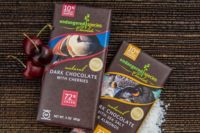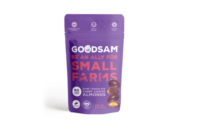Dark chocolate almonds are known and loved by many, and almonds are about the closest thing we have to a “perfect” center for panning. They are usually the first item made in a new panning operation, followed quickly by milk chocolate-coated raisins. But what happens next? Although smaller in sales volume, more complex gourmet-panned items are a great way to create differentiation in your product line.
Gourmet-panned centers can include such items as dried fruits, espresso beans, fondant, fragile nuts, and seeds. It may also include adding spices or flavors. How about using white chocolate to allow flavors to take center stage? Need some ideas? Consider these…
- Cinnamon- , cardamom- and malt-spiced white chocolate almonds
- Honey milk chocolate-coated sunflower seeds
- Cinnamon-dusted cranberries
- Dried ginger and pineapple coated in wasabi-infused dark chocolate
- Maple syrup walnuts coated in milk chocolate and dusted with cocoa and nutmeg
- Mayan cayenne dark chocolate almonds
- Habanero kettle corn nuggets
- Paprika-roasted cashews coated in dark chocolate and rolled in lime-salt seasoning
- Indian five-spice milk chocolate pecans
- Tiramisu-coated espresso beans
- Blood orange-coated apricots
Understanding the hurdles
Given the physics of the rotating pan, a “perfect” center is a smooth, dry sphere that is non-pliable, weighted, doesn’t get sticky or oily when tumbling, and is about a ½ inch in diameter. Likewise, “difficult” centers are items that are flat, curved, soft, greasy, sticky, have ridges, divots, or points, are too light to roll, or are less than ¼ inch, or larger than one inch. Difficult describes the majority of centers — even certain varieties of almonds — so the goal isn’t to avoid, but to learn how to handle these items.
Likewise, dark chocolate is easy to use as it can be handled between 90-110° F, has a sharp cooling curve, and is hard once cold. White chocolate is much more sensitive to heat given the milk content, and once cooled is still somewhat soft. Adding oil-based colors or flavors makes chocolate softer as well, and certain flavors will add viscosity.
There are conditions and techniques that minimize the complications caused by difficult centers and softer, thicker coatings. Four of the biggest areas for control are room conditions, equipment, pre-coating, and coating addition.
Pre-coating
One of the easiest tricks to ensure success in panning centers that are pointed, curved, flat, greasy, soft, or irregular is to pre-coat them. To do so, load the centers into the pan, start tumbling, and add ~0.5 percent gum solution. This can be an in-house formula based on gum Arabic, although commercial options are simple to use and have been developed to minimize moisture. After the gum solution spreads, a dry charge of powdered sugar and cocoa is added in 2-3 applications to create a dusted coating on the centers. The sugar to cocoa ratio can range from straight sugar for white chocolate coated items, up to a 50:50 blend. Too much cocoa, however, makes the product slimy and sticky and negates the point of pre-coating. Multiple layers of gum solution and dry charges may be necessary to fill in divots and ridges as well as cover points. Once the centers have a uniform crust of sugar/cocoa, the product is ready to start coating with chocolate.
Room conditions
Dark chocolate almonds, and milk chocolate raisins to some extent, lull us into a state of complacency when it comes to room environment. Both of these items will continue to work with minimal issues even at temperatures and humidity outside of optimum ranges. Working with white chocolate, or difficult centers is a different story. The humidity of the room is critical and needs to be 35-45 percent.
I know all the books say 50-55 percent, but from personal experience the closer it gets to 50 percent, the more random issues begin to occur. Temperature is best between 55-65° F. Another key factor is that the room must have stable conditions. Loading doors left open may mess with the conditions in less than a minute.
Equipment
Dried fruits and small greasy items like espresso beans or sunflower seeds will need a lighter load in the pan compared to almonds. Generally, a 25-30 percent reduction is a good place to start compared to almonds. Also, a slower pan speed is necessary in order to reduce doubling and prevent heat build-up in the pan. Although pan shapes and size factor in, a 28- to 36-in., tulip-shaped pan should be run at 18-24 rpms. Small items generally require chocolate to be sprayed on, because the heavier application of a piccolo tube or ladling will cause clumping.
Coating Addition
Unlike dark and milk chocolate, which can usually be sprayed continuously with cold air blowing, white chocolate will need extra time to set. So spraying in applications with time in between for the cold air to set the coating is key. Start the process with “clean” chocolate to build a layer, and then move to flavored or spiced before finishing in clean chocolate. This will help the product coat evenly.
There are so many interesting centers and flavor combinations that can be used in panning! Give it a try, and let me know what fascinating delights you’ve created! Contact me at the e-mail below.







